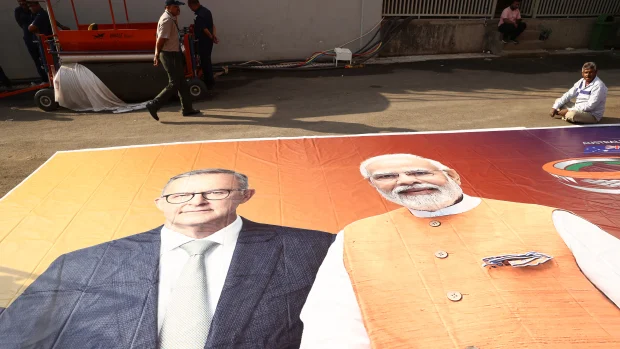India has stopped underestimating Australia’s attractions
By Richard Maude and C. Raja Mohan

The almost startlingly rapid growth of Australia-India relations in recent years is a rare happy by-product of a tense, divided and more dangerous international system.
A “comprehensive strategic partnership” was declared in 2020. Australia is one of a handful of countries with which India holds annual leader-level summits. Remarkably, there were 10 Indian ministerial-level visits to Australia last year.
India wants greater economic self-reliance. Agriculture is politically sensitive. Still, against the odds, the two countries sealed an economic cooperation and trade agreement last year, lowering tariffs on Australian exports and securing better access for service providers.
India is already Australia’s fourth-largest goods and services export market. Even so, making full use of the “interim” agreement will be a feature of Prime Minister Anthony Albanese’s forthcoming visit to India. He will travel with heavyweight Australian CEOs.
Canberra also wants to push on with a “comprehensive” trade deal. This won’t be easy, but India is at the table.
A deeper defence relationship has been built, quietly but purposefully, with a regular schedule of defence exercises, strategic dialogues and training exchanges. The Australian navy participates in India’s Malabar exercise, alongside Japan and the United States.
The difference today is not that the bilateral relationship is friendly – it mostly has been – but that both sides now see an advantage in it and take a strategic perspective of the other.
What of the constraints? These exist but are for the most part well-understood and well-managed.
New Delhi, which traditionally underestimated Australia’s regional and international salience, has elevated Canberra to the A-list of its international partners.
India’s economic needs, including for energy and commodities, and foreign policy interests beyond its neighbourhood, now make Australia a more attractive proposition for its government.
And closer ties with Australia are part and parcel of a gradual but inexorable alignment of Indian and Western interests. This seismic change in India’s worldview is being driven by structural changes in an economy now linked more deeply to the West, a large and influential Indian diaspora in the English-speaking world, and above all the growing and multidimensional challenge from China.
For its part, in the words of Foreign Minister Penny Wong, Australia regards the partnership with India as “critical” to shaping a strategic equilibrium in the Indo-Pacific in which “countries can make their own sovereign choices” and China is not hegemonic.
India’s economy and population mass also make it an important market for Australian trade diversification and an essential partner on climate change and clean energy.
Strategic equilibrium
What of the constraints? These exist but are for the most part well-understood and well-managed.
India wants a multi-polar Indo-Pacific region in which it is one of the poles – a powerful, independent player. This aligns strongly with Australia’s hopes for “strategic equilibrium” and is sufficient convergence to drive the relationship forward: Australia does not expect or need India to operate in the Indo-Pacific as if it were a US alliance partner. Nor, for that matter, does the United States.
Similarly, with an eye to sensitivities in Southeast Asia, Australia is comfortable with Prime Minister Narendra Modi’s framing of the Quad as a provider of public goods in the Indo-Pacific, not a pact to contain China or build an Asian NATO (Modi will visit Australia in May for the Quad summit).
India’s cautious response to Russia’s invasion of Ukraine disappointed many of its friends. It serves as a reminder of the lingering legacies of the Cold War geopolitics that produced a solid partnership between Delhi and Moscow. Still, even here trends favour the West.
India fears a China-Russia axis, but hopes of stopping Russia’s drift into China’s orbit look increasingly forlorn. India’s dependence on Russia for military equipment has been exposed as a vulnerability: the US now supports India’s defence diversification as well as domestic production.
A Taiwan contingency would be a more severe test of the current era of convergence. The West won’t expect India to engage militarily, but it will expect it to take sides in the crushing economic contest that inevitably would follow any Chinese attempt to take Taiwan.
Leaders in Australia and India like to emphasise a shared history as liberal democracies. This runs into the growing concerns in the West about democratic backsliding in India. But those fears must be weighed against India’s central reality – its extraordinary religious, linguistic, and regional diversity that prevents any one community from exercising long-term and absolute hegemony over its polity.
Finally, delivering a busy agenda is not easy. The Indian foreign affairs bureaucracy is small and its workload has grown rapidly. India wants to control the pace of some co-operation. Other partners clamour for attention. Despite the progress of recent years, patience and a long-term perspective pay dividends.
Today, Albanese’s happy fortune is to inherit an unprecedented alignment of interests in Australia-India relations. His task is simple – not to miss the moment.
A comprehensive free trade agreement would be a landmark achievement. India wants more investment from Australia. Delivering education in India would benefit both nations. And defence access arrangements are the new frontier in military ties.